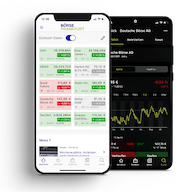Glossary
- b (price addendum)
- B-shares
- Backwardation
- Balance-sheet analysis
- Bar chart
- Base currency
- Base interest rate
- Basis point
- Basis trade
- Basket certificate
- bB (price addendum)
- Bear Call Spread
- Bear flag
- Bear market
- Bear market (baisse)
- Bear trap
- Bearer share
- Bears
- Benchmark
- Beta factor
- bG (price addendum)
- Bid
- Bid price
- Bid-ask spread
- Black-Scholes model
- Blue chips
- Bobl Future
- Bodies of the stock exchange
- Bond
- Bond index
- Bonus
- Bonus certificate
- Bonus shares
- Bonus thresholt
- Book-building
- Bookbuilding range
- Börsenordnung (Stock Exchange Rules and Regulations)
- Börsenrat (Exchange Council)
- Break-even point (warrants)
- Breakout gap
- Bridge capital
- Broker
- Brokerage commission
- Buffett indicator
- Bund Future
- Bundesanstalt für Finanzdienstleistungsaufsicht (BAFin)
- Business angel
- Business plan
- Buyback
Book-building
Unlike the fixed price system, book-building enables institutional and other large-scale investors to participate in the pricing procedure, which involves five steps. The time required to complete each of these steps depends on the issuing volume and the sector in which the company is active.
1. Selection of the lead manager:
The banks in the underwriting syndicate present their IPO strategies in so-called beauty contests. The issuer then selects a lead manger on the basis of criteria such as the consultancy services offered, the strategy for bringing the security to market, the bank’s standing and expertise in the field, and the closeness of the business ties between bank and issuer. (Larger issues such as the privatisation of Deutsche Telekom may be handled by several lead managers.)
2. Pre-marketing:
In this phase, the syndicate members contact potential large-scale investors to ascertain their degree of interest in the security. The syndicate members present their own research material as well as the issuer's offering prospectus, which the syndicate designs in conjunction with the issuer. The offering prospectus contains important information on the company's history, business activities, management, strategic alignment, as well as the relevant markets and its position vis-à-vis competitors. This information enables potential investors to assess more accurately the opportunities and risks of the issue. On the basis of discussions with institutional investors, the syndicate and the issuer agree on a price range for the offering price. The difference between the upper and lower values of the price range may be as much as 10 to 15 per cent.
3. Marketing:
The marketing phase begins when the price range is announced at a press conference. The issuer’s executive board then presents the company at ’’road shows’’
, i. e. public events, analysts' conferences, and meetings with both domestic and foreign institutional investors. Private investors are informed of the pending issue by their personal financial consultants.
4. Order-taking:
This phase begins shortly after the inception of marketing activities. When syndicate members receive subscription requests, they fill out order forms which they then forward to the lead manager (also called "book runner"). The forms contain information on the subscriber's identity (name and nationality), what kind of investor the subscriber is (e.g. insurance company, pension fund, investment fund, private investor) the volume of shares desired, the price offered, and the investment strategy (short-term, medium-term, long-term). The identity of institutional investors is disclosed only with the subscriber's explicit consent, and the names of private investors are generally not disclosed at all.
The book runner enters all subscription orders received into an electronic order book. The orders are then evaluated so that preference can be given to long-term investors when the securities are distributed. By carefully choosing future investors, the lead manager can contribute to price stability and inspire confidence that the security will be valued fairly.
5. Price determination and allocation of shares:
Order-taking is followed by a subscription period which normally lasts from eight to ten days. Afterwards, the book runner analyses the price elasticity of demand on the basis of the information provided in the subscription requests, usually assisted by a computer-driven scoring procedure that takes into account criteria such as investment horizon. On the basis of this analysis, the book runner determines a single offering price in agreement with the issuer (in some cases, different prices will be set for private investors and institutional investors). In allocating the securities, the book runner achieves the desired mix of investors by instructing the syndicate banks to set aside a certain number of shares to institutional investors (directed allocation). The book runner also makes available a certain quantity of shares to be distributed equally among for private subscribers (free retention).
The so-called green shoe has an important function in the allocation of shares. This is an agreement between the issuer and the syndicate banks which states that the issuer will provide a certain number of additional shares (a type of reserve) to be distributed by the syndicate at the original price should the demand for the security be considerably higher than expected. The green shoe helps stabilise the price of the share after exchange trading in the shares has begun.
Antonym: Fixed-price offering system




